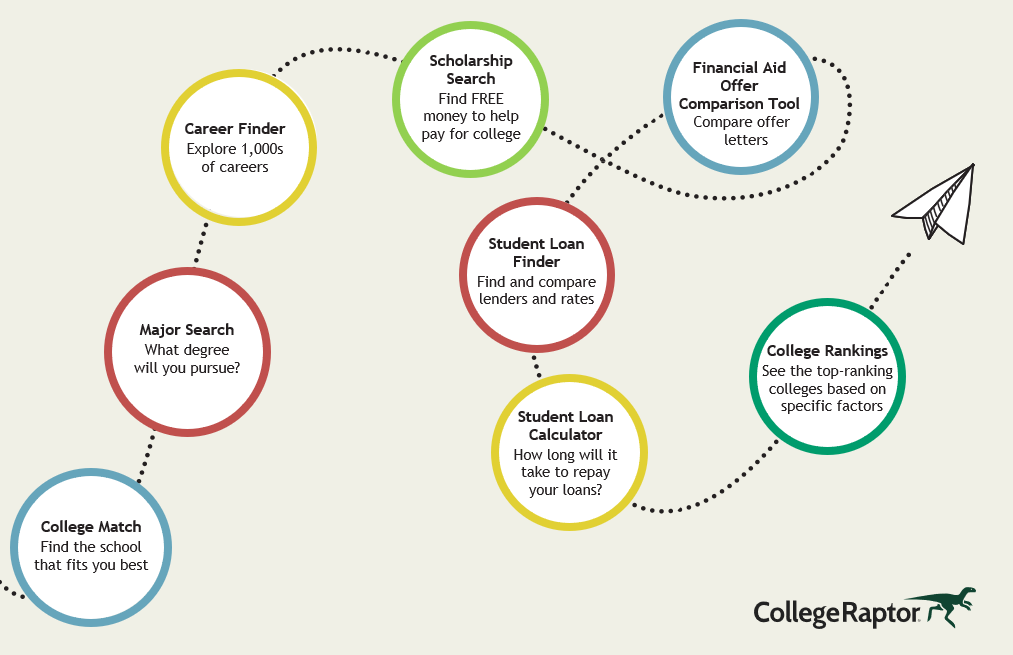Preparing and planning for college takes time, and it can be tough to keep track of everything you need to do. A checklist, like this one from College Raptor, can help you stay organized. In this guide, though, we’ll take it a step further and dive into everything you need to know about college planning.
When you’re planning to go to college, there’s a lot that needs to be done – it’s more than simply sending in applications to schools! You actually need to decide where to send those applications, after all. And although they may not be due until January 1st of your senior year, that doesn’t mean you should wait until December 31st to send them in. Follow this easy college planning guide to get you started.
1. Think About Your Goals and Passions
First up, you should be giving careful thought to what you want out of college and beyond. It’s more than just an extension of high school – the college or university you chose can have lasting implications on your future life! It’s a big decision, and there’s a lot to consider before you can submit applications.
These questions will give you a good starting point:
- What careers, industries, and fields interest you?
- What are your strengths and weaknesses?
- Do any particular majors call you?
- Do these majors align with your career goals and interests?
- What’s important to you in life (salary, job satisfaction, giving back, etc)?
- What are your academic goals?
- What are your career goals?
2. Identify The Right Type of College for You
There’s more to higher education than just “college.” There are different types of colleges, universities, and schools out there!
Community College
Often called 2-year colleges, community colleges tend to offer Associate’s degrees and certificates to their students. They have high acceptance rates and can be a great way to save money and get your general education requirements finished before attending a 4-year college. Most students who go to a community college live in the surrounding areas. They do not usually have dorm rooms and tend to have fewer sports and clubs compared to 4-year schools.
4 Year College
A 4-year college or university is a school that offers at least a Bachelor’s degree, but universities will usually also offer master’s and doctoral degrees. These can be large or small schools, but they tend to have dorm rooms and larger campuses than community colleges.
4-year colleges can also be public or private. Public universities tend to rely heavily on state funds and can be less expensive to attend compared to their private counterparts. Private schools are funded by tuition and donations and also tend to offer more in the way of financial aid for their students.
Trade Schools
Trade or vocational schools train students with hands-on experience in their chosen career field. Plumbers, welders, and car mechanics are three jobs that are usually done with these types of schools. The length of time they take depends on the student’s intended career.
3. Decide What You Want Out of Your College Experience
Another set of considerations you need to make is what you want during the college experience. One student may want to attend a large university in a big city. Another may want a more quaint setting with smaller class sizes. Part of this is deciding the type of college you want to attend, but you should also consider your desires:
- Location, area, state, etc
- Rural vs urban
- Class size
- Major and minors and the availability and reputation of the programs
- Cost and financial aid package availability
- Clubs, sports, and extracurriculars
- Campus size
- Type of school and how that impacts your plans after graduation
Your needs and wants out of a school may go beyond these suggestions, too. So you’ll want to start to make a running list of what’s important to you in a college. As you get your search underway, you might find other aspects that are necessary that you’ll want to add to that list.
4. Start The Search for Colleges
After you have all of this information in hand, you can start your search for colleges. You’ll want to look for a good mix of safety, reach, and target schools that fit your goals and achievements. Students can find colleges through their high school, guidance counselors, and local college fairs.
While you can also look up colleges online, this can be a shoot in the dark. Google, for example, does not take your wants and needs in a school into account. And you could find what you thought was a good college for you, but then discover it doesn’t even have your intended major.
However, tools like our College Match allow you to speed up the process. Simply input your information and your wants and needs in a college, and you’ll get results that fit you! It rules out schools for you and returns with information that is pertinent to your achievements, goals and wants.
5. Develop a Schedule
Your next step should be to create a schedule. This schedule should outline all important dates such as SAT and ACT test dates, application deadlines, information for Early Action and Early Decision, Free Application for Federal Student Aid details, and more. Post this information where you can clearly see it.
Of course, this isn’t everything you need to do to prepare for college, but this guide will give you a head start on actually planning for your college search and finding the right schools for you. Taking these steps will save you money in application fees and a lot of time not only on uncovering colleges that fit you as a student but on the applications themselves.
If you’re ready to get started on the college planning process, we invite you to use our College Match tool. It’s easy to use and free! All you have to do is sign up here to get started.






